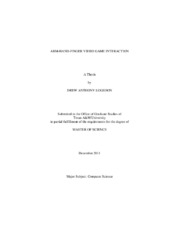| dc.description.abstract | Despite the growing popularity and expansion of video game interaction techniques and research in the area of hand gesture recognition, the application of hand gesture video game interaction using arm, hand, and finger motion has not been extensively explored. Most current gesture-based approaches to video game interaction neglect the use of the fingers for interaction, but inclusion of the fingers will allow for more natural and unique interaction and merits further research.
To implement arm, hand and finger-based interaction for the video game domain, several problems must be solved including gesture recognition, segmentation, hand visualization, and video game interaction that responds to arm, hand, and finger input. Solutions to each of these problems have been implemented.
The potential of this interaction style is illustrated through the introduction of an arm, hand, and finger controlled video game system that responds to players' hand gestures. It includes a finger-gesture recognizer as well as a video game system employing various interaction styles. This consists of a first person shooter game, a driving game, and a menu interaction system. Several users interacted with and played these games, and this form of interaction is especially suitable for real time interaction in first-person games. This is perhaps the first implementation of its kind for video game interaction. Based on test results, arm, hand, and finger interaction a viable form of interaction that deserves further research.
This implementation bridges the gap between existing gesture interaction methods and more advanced virtual reality techniques. It successfully combines the solutions to each problem mentioned above into a single, working video game system. This type of interaction has proved to be more intuitive than existing gesture controls in many situations and also less complex to implement than a full virtual reality setup. It allows more control by using the hands' natural motion and allows each hand to interact independently. It can also be reliably implemented using today's technology.
This implementation is a base system that can be greatly expanded on. Many possibilities for future work can be applied to this form of interaction. | en |


